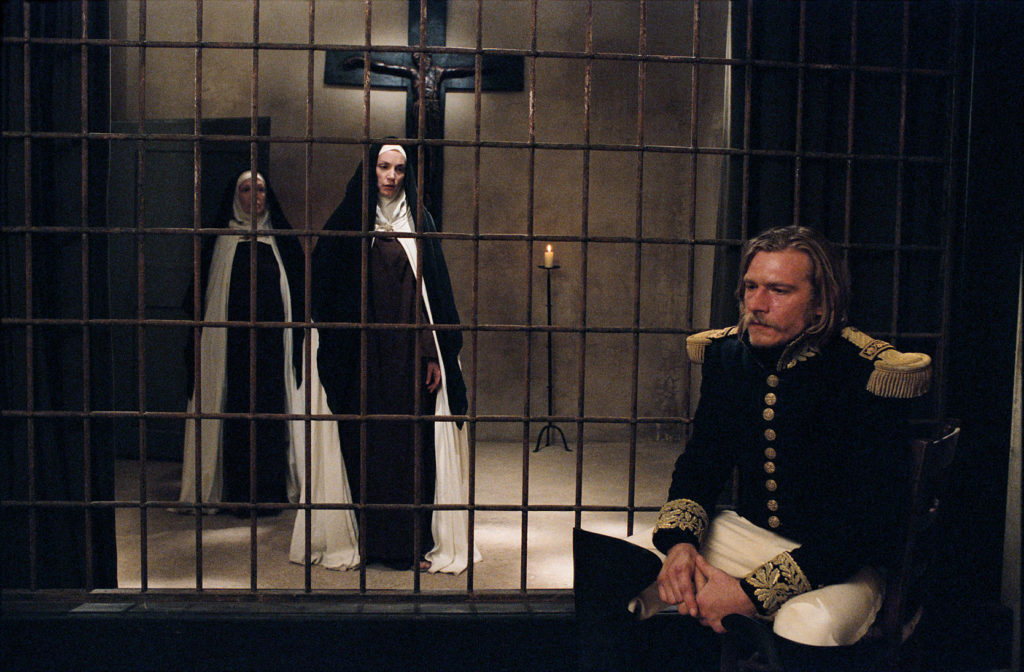The Duchess of Langeais
James Naremore
Jacques Rivette’s new film deserves analysis not only for its dramatic power but also for its specific virtues as a costume picture adapted from a nineteenth-century novella by Balzac (an author Rivette has adapted before, in La Belle Noiseuse). Set largely in Restoration Paris and told in flashback, the film concerns a frustrated love affair between a Napoleonic-era military officer, Gen. Armand de Montriveau (Guillaume Depardieu, who died in 2008), and a flirtatious aristocrat, the Duchess of Langeais (Jeanne Balibar). The general is a leonine, scowling romantic with a wooden leg (Depardieu was an actual amputee) and the duchess a raven-haired, ultramontane Catholic with the seductive body of a dancer. Rivette, who has long been interested in the relation between theater and cinema, emphasizes the theatrical nature of their affair. The duchess invites the general to a series of private meetings in her home (her husband is permanently absent) and subjects him to The Big Tease, carefully controlling her costume, hair, lighting, and mise-en-scene, ultimately turning him into her “orderly.” Five years later, after spurning him, then falling truly in love with him, and then being rejected by him in return, she joins an order of barefoot Carmelites in Spain. When he finds her at the nunnery, a scarlet curtain drops to reveal her standing on an empty stage, where she has been singing a mournful song of parting (“River Tage,” by J. H. Demeun and B. Pollet).
The film is especially interesting for the way it respects what Lionel Trilling, in an essay entitled “The Sense of the Past,” calls “historicity.” Many older works of literature, Trilling points out, are acceptable only when they are understood to have been written in the past; indeed their pastness is inseparable from their positive aesthetic effect. In adapting Balzac, Rivette avoids pastiche but is sensitive to the nineteenth century’s historically available expressive conventions. He achieves suspense, an air of estrangement, and sometimes a comic irony from the conflict between highly formalized manners and impulsive romanticism, and he makes good use of intertitles to convey the rather arch tone of Balzac’s narration. His approach is quite different from Catherine Breillat’s overtly sexy The Last Mistress, which is an adaptation of a nineteenth-century novel about a similar milieu, and in some ways closer to the austere historicism of Rossellini’s Rise to Power of Louis XIV. Like Rossellini, Rivette appreciates the value of dramatic pauses, long takes and real duration. The Duchess of Langeais is a leisurely film (two hours and seventeen minutes), confined mostly to interiors, directed in a style that provides a correlative to Balzac’s leisurely fiction. Some of its best dramatic effects are the moments when the general silently waits for the duchess, or when his wooden leg clomps across the floorboards of a society ballroom and the marble stones of a church. Rivette makes no attempt to be completely “faithful” to his source, but he intelligently adapts Balzac and in the process creates a detached yet quietly intense dramatization of amour fou.
James Naremore is Emeritus Chancellors’ Professor of Communication and Culture, English, and Comparative Literature at Indiana University. His books include More Than Night: Film Noir in its Contexts, Acting in the Cinema, The Magic World of Orson Welles, The Films of Vincente Minnelli, On Kubrick and An Invention Without a Future: Essays on Cinema.
________________________________
The text, “The Duchess of Langeais,” is excerpted from “Films of the Year, 2008,” Film Quarterly 62.4 (Summer 2009), 20-33 (p. 31). Reprinted by Permission.
The Cine-Files, issue 12 (spring 2017)

